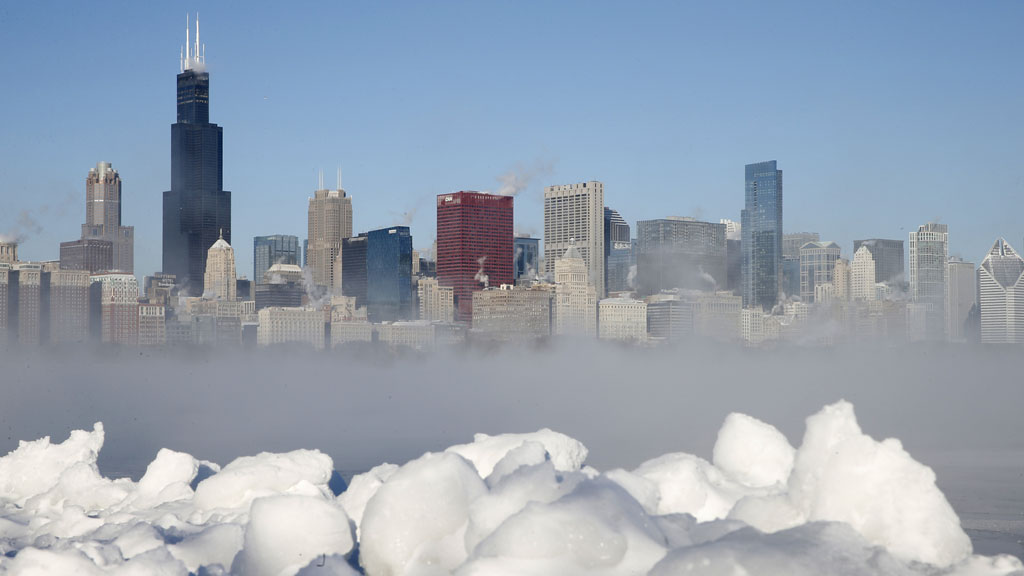Polar vortex: counting the cost of the US cold weather
With warmer weather on its way for the American Midwest, the US is now preparing to count the financial cost of the extreme cold that has gripped the country.
From homeowners to airlines, the extreme cold weather will have a major financial impact, with one expert suggesting that the total bill from the extreme cold could come to $5bn.
Meanwhile the human cost of the extreme weather has been made clear with at least nine deaths attributed to the surge of polar temperatures across North America.
We think that the problem will be short-lived, but we estimate it will cost about $5bn because of the sheer size of the population affected. Evan Gold, Planalytics
Among the deaths that have been reported are a 51-year-old homeless man in Georgia whose body was found outside, two men who fell into a river whilst duck-hunting in Massachusetts, a skier killed in an avalanche in Colorado and an elderly woman found in her home in Indianapolis.
Shelters for homeless people have been overwhelmed in the arctic conditions, electricity suppliers struggled to keep up with the demand for energy and schools were closed.
Economic impact
Evan Gold, senior vice president at business weather intelligence company Planalytics, said that the cost to the US economy would be felt in lost productivity, a lack of consumer spending and higher heating bills.
He said: “We think that the problem will be short-lived, but we estimate it will cost about $5bn because of the sheer size of the population affected — about 200 million people in the eastern two-thirds of the country.”
While most winter storm losses occur in northern and mountainous regions of the United States, this week’s polar vortex threatens millions of homeowners in the south who may be unprepared for extreme cold. Dr Robert Hartwig, Insurance Information Institute
At least 15,000 US flights have been cancelled since Sunday morning.By comparison, 2010-2011 has been reported as possibly the most expensive season ever for US domestic airlines in terms of cancellations, costing around $600m. At the time, Airline Forecasts estimated that the cost of each missed flight was $7,000.
This means that so far, the bill for domestic US airlines for three days of cold weather could already be over $100m.
But it is not just business that will feel the economic impact of this winter storm. The US public can expect to be hit by “surprise bills” from increased energy consumption, Mr Gold warned.

Homeowners will be hoping that insurance plans cover any damage to their properties, including burst water pipes and damage caused by trees.
An average $1.4bn is paid out each year by US insurers to cover damage caused by severe winter weather, though this is normally confined to specific parts of the US.
Dr. Robert Hartwig, president of the Insurance Information Institute, said: “While most winter storm losses occur in northern and mountainous regions of the United States, this week’s polar vortex threatens millions of homeowners in the south who may be unprepared for extreme cold.”
He said that winter storm claims accounted for 7.1 per cent of all insured catastrophe losses between 1993 and 2012, behind hurricanes and tropical storms (40 per cent) and tornadoes (36 per cent) as the costliest natural disasters.
Restaurants and retailers are also likely to take a hit from people staying indoors in the harsh conditions.
The sunny side
However, it is not all bad news, investment website The Motley Fool, has said. A number of industries are likely to see a sunny side from the freezing conditions.
Car repair companies, winter clothing providers and natural gas utility companies are polar vortex “winners”, the company said. Companies such as Autozone, Columbia Sportswear and national Fuel Gas have all seen share price boosts since the start of the year.
However, the main economic damage has been caused by the unprecedented nature of this severe weather.
As Scott Bernhardt, president of Planalytics says: “When it gets this cold, this extremely cold, things start breaking down and that’s money to the state and local governments that they haven’t necessarily budgeted.
“They tend to budget their snow budget based on last year or the last couple of years but… this is the coldest it’s been in 20 years and in an awful lot of major population centres.”
-
Latest news
-
As India goes to the polls in the world’s largest election – what do British-Indians think?6m

-
Tees Valley: Meet the candidates in one of the biggest contests coming up in May’s local elections4m

-
Keir Starmer says public sector reform will be a struggle7m

-
Nicola Sturgeon’s husband Peter Murrell charged with embezzlement of funds from SNP1m

-
Ukraine might finally get $60billion in American weapons and assistance to defend against Russia3m

-




